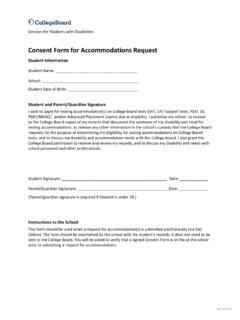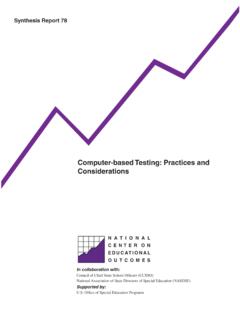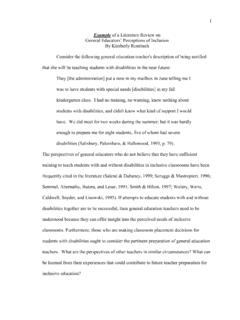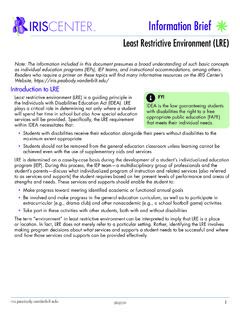Transcription of Classroom Accommodations for ADHD Students
1 Classroom Accommodations for adhd Students It is hardly any secret that every Classroom has Students who have a hard time paying attention and probably a couple of kids with a diagnosis of Attention Deficit Hyperactivity Disorder ( adhd ). Some parents of adhd Students may wish to have formal Accommodations written into a document that is often referred to as a 504 Plan (because it refers to section 504 of the Americans with disabilities Act). This plan identifies the steps to be taken to help insure that Students with diagnosed difficulties are provided opportunities to learn with support to maximize their abilities and accommodate their challenges.
2 While the ideas below are especially useful for teachers working with children and teens with attentional difficulties, many of these techniques are just good teaching and useful for enhancing the learning of all Students . Areas of accommodation : Classroom environment and seating Classroom has predictable daily routines Schedule changes are discussed ahead of time Consistent and clear limits are set for Classroom behavior Work alternates short concentrated periods with breaks Visual distractions in Classroom are minimal Auditory distractions in Classroom are minimal Small group instruction Team teaching Identify teaching-style/student match ( structured, nurturing, etc.)
3 Seat in front of Classroom Seat in quiet area Seat near teacher Seat near good role model Seat near 'study buddy' Increase distance between desks Reduce distractions on or near desk Minimize use to tables that would have another sitting facing the student with an accommo0dation Seat away from distracting stimuli Seat in study carrel or use partitions (beware that this could also create stigma) Build a solid rapport with adhd Students ; recognize them out of class, use their names when you address them, and praise their accomplishments. Assigned work is posted on the board and on the internet Assignments/Homework Extra time to complete assigned work Shorten assignments/work periods Simplify complex directions Break long assignments into smaller parts Assist student in setting short term goals Pair written instructions with oral instructions Develop private signal from pupil to teacher to request repetition of oral directions Repeat oral instructions Check homework daily Reduce amount of homework Limit homework to _____ minutes per night Limit home SSR, simultaneous reading.
4 Or family reading to _____ minutes per night Permit assignments to be printed or typewritten without penalty Permit writing assignments to be turned in on audio-file Permit writing assignments to be given orally Permit extra credit assignments Permit re-submitted assignments Adapt assignment to minimize writing ( circle, cross out, write above line, etc.) Do not grade or minimize emphasis on handwriting Do not grade or minimize emphasis on spelling Test Taking and Grading Provide written outline of main points prior to test Allow open book exams Allow outline or notes during exams Give exam orally Give take-home tests Allow student to dictate answers on tape recorder Give frequent short quizzes rather than long exam Allow extra time for exams Allow test to be taken untimed with specified short breaks Read test item to student Provide student with following information.
5 Grade performance relative to normal grade level expectations (traditional grade) Grade for apparent effort Grade performance relative to own growth and improvement (progress compared to own previous achievement) Avoid using child as negative example to others Avoid questioning child's motivation or effort Encourage child to accept own mistakes Identify whether test will assess abilities or disabilities Home/School/Community Communication Parent/teacher conference frequency _____ Teacher/student conference frequency _____ Parent/student/teacher conference frequency _____ Provide daily/weekly progress checklist Call parent if _____ Provide case manager/school social worker to give lead in communicating within school, and between school, home and community.
6 This includes assistance in selection of teachers; and teacher, aides, bus driver and administration orientation and awareness regarding nature of disability and adaptation needs and monitoring effectiveness of this adaptation plan. Monitor medication taking Assist physician in medication monitoring Consult with other professionals: _____ once per _____ Transportation Select seating and seat buddy on bus, not in rear of bus Provide adult supervision on bus Medication Provide discrete reminder to student to obtain medication Take care not to humiliate student with respect to medication (this is only addressed to situations where student has had previous bad experience).
7 Aides and Technology Use highlighters to assist to student in identifying what is important Provide peer assistance/adult assistance in note-taking Provide tape recorder and permit tape recording of class Provide keyboarding skills training Provide computer with appropriate software for written assignments (word processing software includes spelling-prompt software, etc.) Provide computer for in-class note-taking Provide instructional software in subject matter area: _____ (semi-independent, self-paced, repetition, variety, multi-sensory, non-judgmental feedback) Provide textbooks on audio tape ( through aural media catalogue)
8 Provide opportunity to complete written assignments on computer Provide extra set of textbooks which may be marked Provide enlarged copy of reading assignments/written assignments Provide tutor for specified period of time and frequency Learning style Using or enhancing visual, auditory, and kinesthetic learning and memory Provide auditory directions Provide auditory cues and clues Develop auditory mnemonics skills ( set memorization tasks to music) Do or do not use background music to enhance learning (headphones or ambient) Provide visual directions, demonstrations and representations Provide visual cues and clues Develop visual conceptualization skills Develop visual mnemonics skills Encourage (multi-colored)
9 Outlining/underlining when reading Maintain visual contact while talking Use tactile and manipulative aides in teaching Provide simultaneous visual, auditory, and kinesthetic experiences Provide lessons in sequential order Provide lessons with contextual clues Provide written outline of lesson or written notes of lecture material Write main points of lesson on board Refer for academic testing in particular area Accept alternatives to oral reports (written, display, etc.) Utilize areas of strength to encourage expression Involve child in movement several times a day Attention Provide cognitive behavioral feedback.
10 Positive feedback for attention to task (frequency based on what student can currently do) short-term reinforcers ( happy face, check mark, star, in-class rewards) and long-term ( accumulate points for rewards at home) Plan academic instruction for student's peak attention time ( , ) Allow student to stand at times during seatwork (especially during end of task) Require active responses in instruction (talking, moving, organizing, working at board, interacting with computer) Provide opportunity for 'seat breaks' (structure with errands, physical activity, etc.) Provide short break between assignments Give child substitute verbal or motor responses to make while waiting Provide fidget object for manual activity ( koosh ball, clay, worry beads, etc.)








